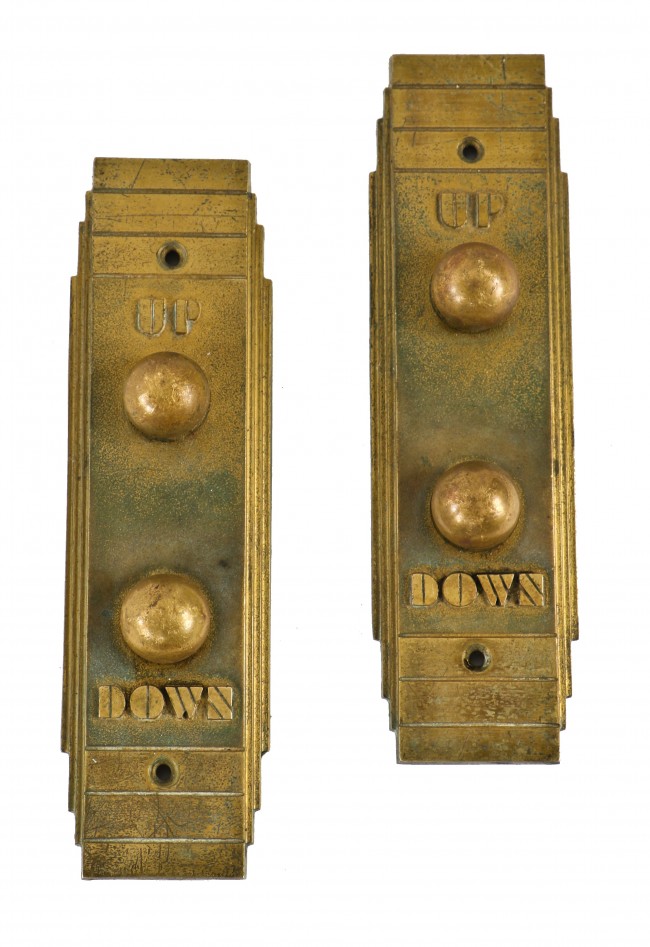
matching set of original historically-important c. 1933-34 chicago world’s fair “sky ride” attraction cast bronze elevator up/down cab “call” push button plaques – otis elevator company, new york city, ny
UR-22038-51
Category
Chicago BuildingsAbout This Item
remarkable all original machine age skyscraper style chicago “century of progress” c. 1933-34 world’s fair cast bronze sky ride push button up/down elevator cab call plaques designed and fabricated by or for the otis elevator company, new york city, ny. the signature attraction was constructed in part, by the otis elevator company. the matching push button plaques were used as the “automatic signal controls” for the fair’s ride. each plaque features distinctive cast brass ball-shaped buttons mounted below and above the “up” and “down” words consisting of embossed, block lettering. the mutli-tiered and/or stepped profile was a very popular design motif used during this period. the american art deco elevator cab call plates contain a nicely aged surface patina consistent with age. the sky ride was an attraction built for the century of progress exposition (or chicago world’s fair) in 1933. it was a transporter bridge (oraerial tramway), designed by the bridge engineering firm robinson & steinman, that ferried people across the lagoon in the center of the fair. it was demolished after having carried 4.5 million riders during the run of the fair. the sky ride had an 1,850-foot span and two 628-feet tall towers, making it the most prominent structure at the fair. suspended from the span, 215 feet above the ground, were rocket-shaped cars, each carrying 36 passengers. the century of progress exposition committee sought an exciting signature attraction, one that would be remembered like the eiffel tower from the1889 paris world’s fair or the ferris wheel of the 1893 chicago world’s fair. one proposal under consideration, to be underwritten by montgomery ward, was called the tower of water and light—a 250-foot-tall tower with water flowing down the outside and elevators traveling to observation platforms. when the montgomery ward company backed out of its offer to finance the tower, the commission considered the sky ride. the sky ride, an idea suggested by an engineer named william l. hamilton, would span the grounds and be relatively cheap to build.[2] the ride was built in the span of six months prior to the fair’s opening, by a consortium of five companies: great lakes dredge and dock company, inland steel,john roebling and sons, mississippi valley structural steel and otis elevator at a cost of about 1,000,000 usd. the ride had a capacity of 5,000 people per hour. it was reported that the attraction had 2,616,389 riders in 1933 and a total of about 4.5 million during the course of the fair. at the time of construction the span between towers was one of the longest in the world, allegedly exceeded in span only by the george washington bridge, and the towers were higher than any of the skyscrapers then extant in chicago. it was reported that it contained 2,000 tons of steel, 100 miles of cabling and that the cableway had a breaking strength of 220,000 pounds per square inch. the sky ride was demolished at the conclusion of the fair. the west tower was brought down using 120 pounds of dynamite. the east tower was toppled on august 29, 1935 using 1,500 pounds of thermite charges to melt ten-foot sections near the bottom of two of the legs. when the thermite was fired, the two legs collapsed and the tower fell on its side the sky ride consisted of two towers, each 628 feet high, spaced 1,850 feet apart. each tower had four elevators with a 30 person capacity. fair goers could take a trip across from one tower to the other at the 200-foot level, or take the elevator farther up to the observation decks at the top of the tower. there were two decks per tower and bausch and lomb supplied the 12 coin-operated telescopes on the tower observation decks. if they chose to take a trip across, they rode in one of 12 double-decked “rocket cars” carried across from one tower to the other. each car emitted steam intended to resemble a “tail” or rocket exhaust, as it traveled across the wires. at night, lights were focused on the cars as they traveled between the towers, and lights were also attached to the bottom of the elevators. the transporter bridge, a very rare type of bridge, is more common in europe. in the united states, only two transporter bridges were ever built: the aerial lift bridge in duluth, minnesota in 1905, and the sky ride. due to capacity constraints, the duluth bridge was converted from a transporter bridge to a more conventional vertical lift bridge with a raisable through truss span in 1930. thus, the count of transporter bridges existing at a given time in the us never exceeded 1, and after november 1934, stands at zero again.










